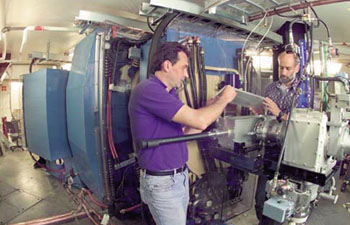1999 looks to be a vintage year for “superheavy” nuclei. These heavier-than-uranium isotopes are a 20th-century postcript to the Periodic Table.

Soon after the experiments at Dubna, which synthesized element 114 and made the first footprints on the beach of the “island of nuclear stability”, two new superheavy elements have been discovered at the Lawrence Berkeley National Laboratory.
Element 118 and its immediate decay product, element 116, were manufactured at Berkeley’s 88 inch cyclotron by fusing targets of lead-208 with an intense beam of 449 MeV krypton-86 ions.
Although both new nuclei almost instantly decay into lighter ones, the decay sequence is consistent with theories that have long predicted the island of stability for nuclei with approximately 114 protons and 184 neutrons.
Theorist Robert Smolanczuk, visiting from the Soltan Institute for Nuclear Studies in Poland, had calculated that this reaction should have particularly favourable production rates. Now that this route has been signposted, similar reactions could be possible: new elements and isotopes, tests of nuclear stability and mass models, and a new understanding of nuclear reactions for the production of heavy elements.
The 118-isotope, identified at Berkeley, contains 118 protons and 175 neutrons in its nucleus. Less than 1 ms after its creation, it decays by emitting an alpha particle, leaving behind an isotope of nucleus 116, containing 116 protons and 173 neutrons. This alpha-decays in turn to an isotope of element 114. The chain of successive alpha decay is observed until at least element 106.
Vital to the experiment was the newly constructed Berkeley Gas-filled Separator (BGS). Another important factor was the versatility of the 88 inch cyclotron, in operation since 1961 and recently upgraded by the addition of a high-performance ion source.
It is incongruous that this new transuranic nucleus was discovered at Berkeley only a few months after the death of Glenn Seaborg, co-discoverer at Berkeley of plutonium and nine other elements heavier than uranium, the heaviest naturally occurring nucleus.





